Advanced Jenkins
Pipeline Structure and Scripted vs Declarative
Scripted Pipeline K8S Agent
In this lesson, you’ll learn how to run scripted Jenkins pipeline stages inside Kubernetes Pods using the Jenkins Kubernetes plugin’s podTemplate. We’ll compare a Declarative Pipeline on a static agent versus a Scripted Pipeline on a dynamic K8s agent, then walk through defining pod templates and share a full example.
Prerequisites
- Jenkins server with the Kubernetes Plugin installed
- Access to a Kubernetes cluster and a configured Kubernetes cloud in Jenkins
- Credentials for any external services (e.g., MongoDB, Gitea) stored in Jenkins
Declarative Pipeline Example
Here’s a standard Declarative Pipeline bound to a static Jenkins agent:
pipeline {
agent {
node {
label 'ubuntu-docker-jdk17-node20'
environment {
NODEJS_HOME = "${tool 'nodejs-22-6-0'}"
PATH = "${env.NODEJS_HOME}/bin:${env.PATH}"
MONGO_URI = "mongodb+srv://supercluster.d83j"
MONGO_DB_CREDS = credentials('mongo-db-creds')
MONGO_USERNAME = credentials('mongo-db-user')
MONGO_PASSWORD = credentials('mongo-db-pass')
SONAR_SCANNER_HOME = tool 'sonarqube-scanner'
GITEA_TOKEN = credentials('gitea-api-token')
}
}
}
properties {
// repository properties
}
stages {
stage('Installing Dependencies') {
steps {
sh 'npm install'
}
}
stage('Dependency Scanning') {
steps {
sh 'npm audit'
}
}
stage('Unit Testing') {
steps {
withCredentials([usernamePassword(credentialsId: 'credential')]) {
sh 'node -v'
sh 'npm test'
}
}
}
}
}
$ git checkout -b pipeline/scripted
Switched to a new branch 'pipeline/scripted'
To switch this Declarative Pipeline onto Kubernetes Pods, update the agent block:
pipeline {
agent {
kubernetes {
cloud 'dasher-prod-k8s-us-east'
yamlFile 'k8s-agent.yaml'
defaultContainer 'node-18'
}
}
environment {
MONGO_URI = "mongodb+srv://supercluster.d83jj.mongodb.net/super"
MONGO_DB_CREDS = credentials('mongo-db-credentials')
MONGO_USERNAME = credentials('mongo-db-username')
MONGO_PASSWORD = credentials('mongo-db-password')
GITEA_TOKEN = credentials('gitea-api-token')
}
// ...
}
Scripted Pipeline with podTemplate
For Scripted Pipelines, the podTemplate step defines how Jenkins spins up Pods. You have two main options:
- Define Pod Templates in the Jenkins UI
- Generate with the Snippet Generator
1. Defining Pod Templates in the Jenkins UI
Navigate to Manage Jenkins → Configure Clouds → dasher-prod-k8s-us-east and click Add Pod Template. Configure Name, Namespace, Labels, Usage, then add container templates:
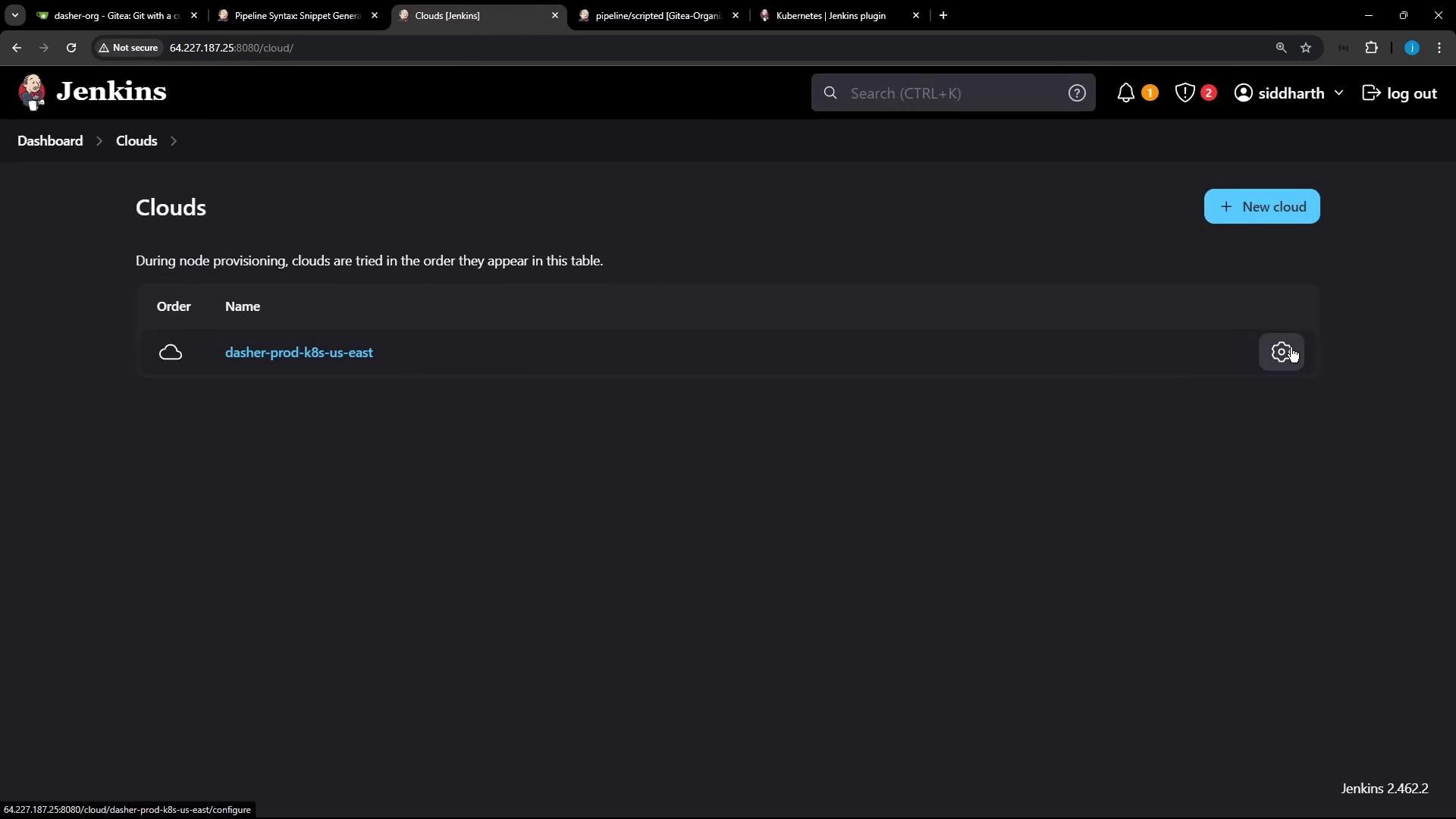
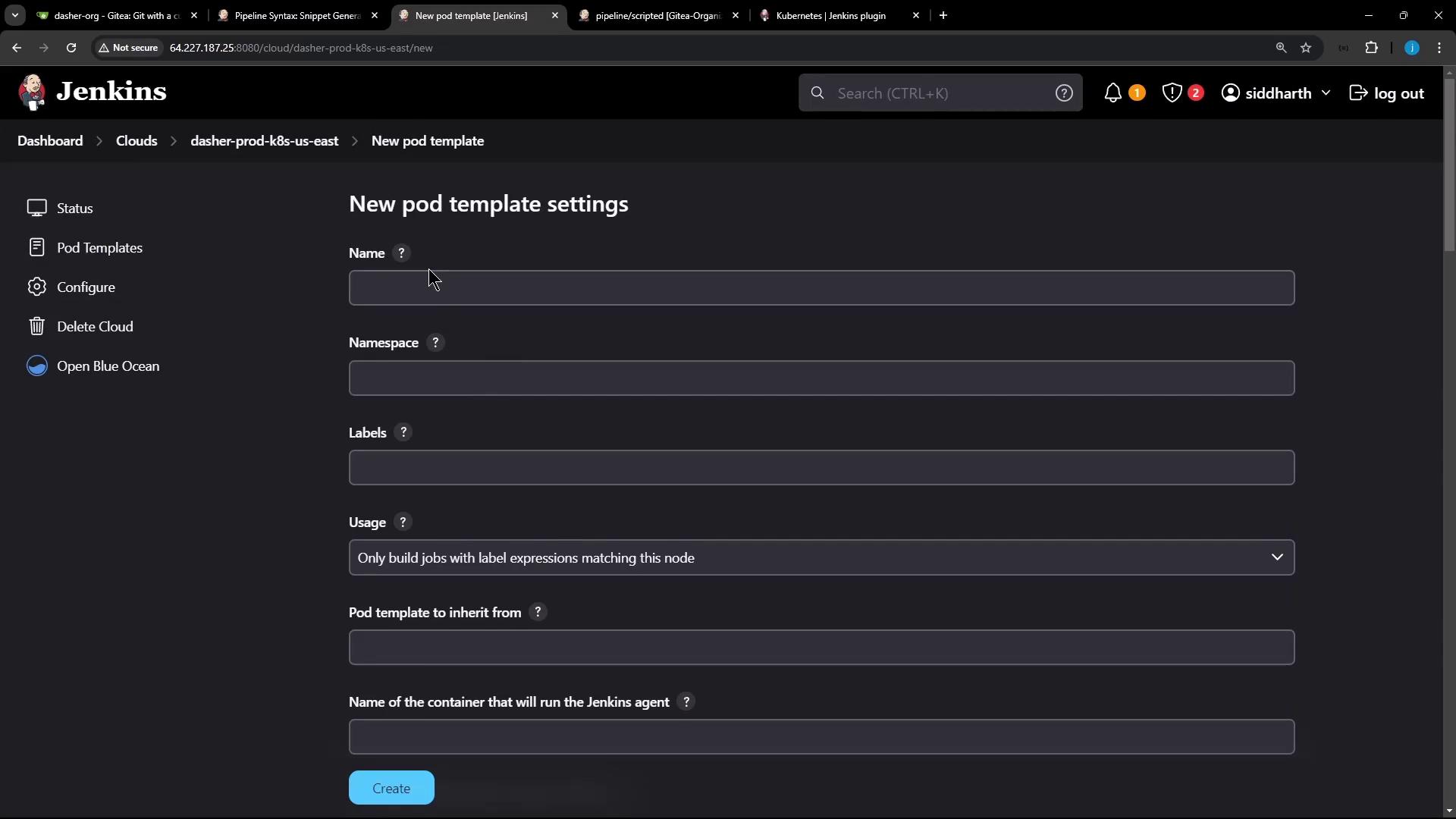
2. Using the Snippet Generator
Open Pipeline Syntax → Snippet Generator, choose podTemplate, then select your cloud and a unique label (e.g., nodejs-pod). Click Add Container Template:
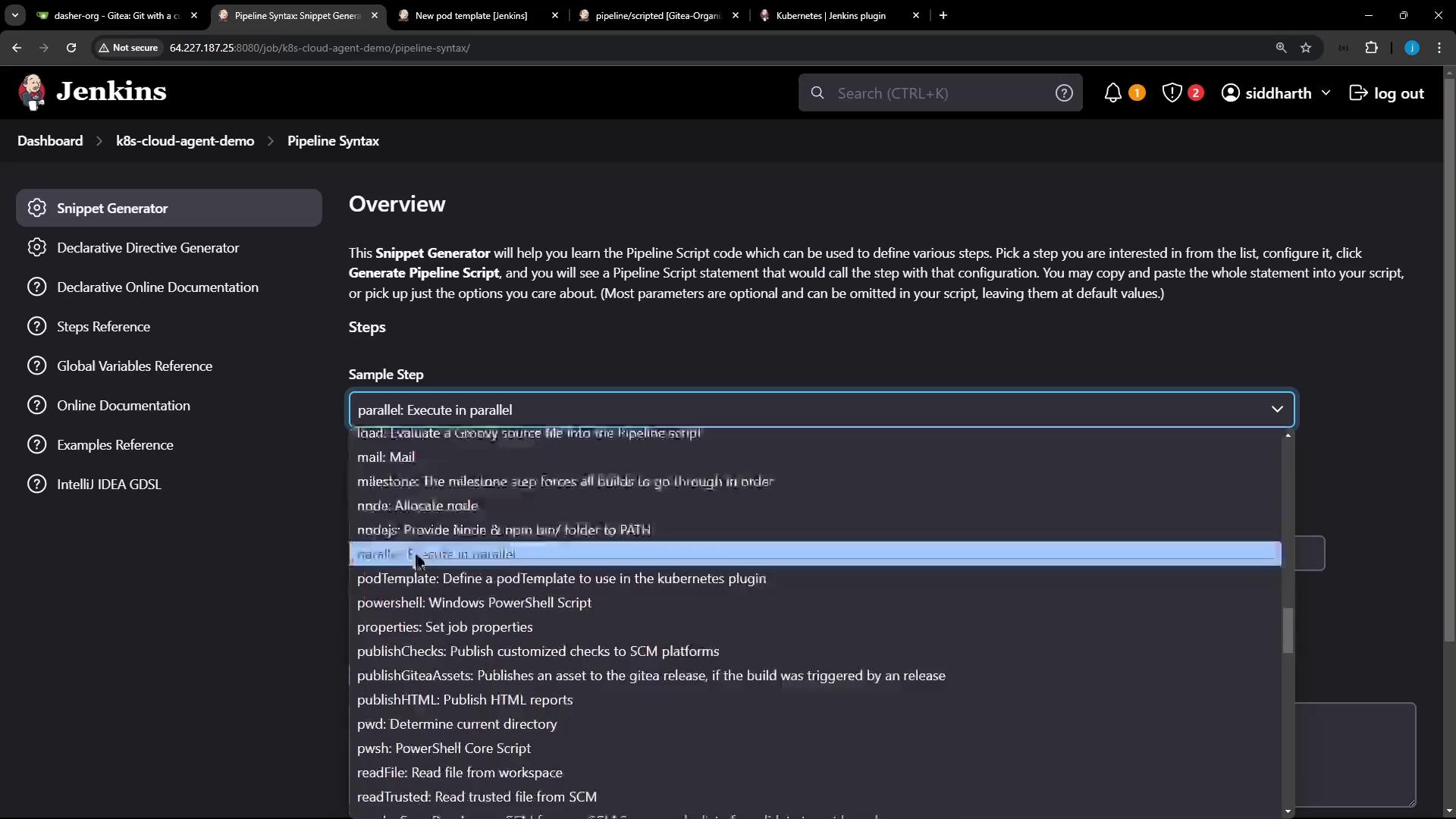
Configure the pod label and usage:
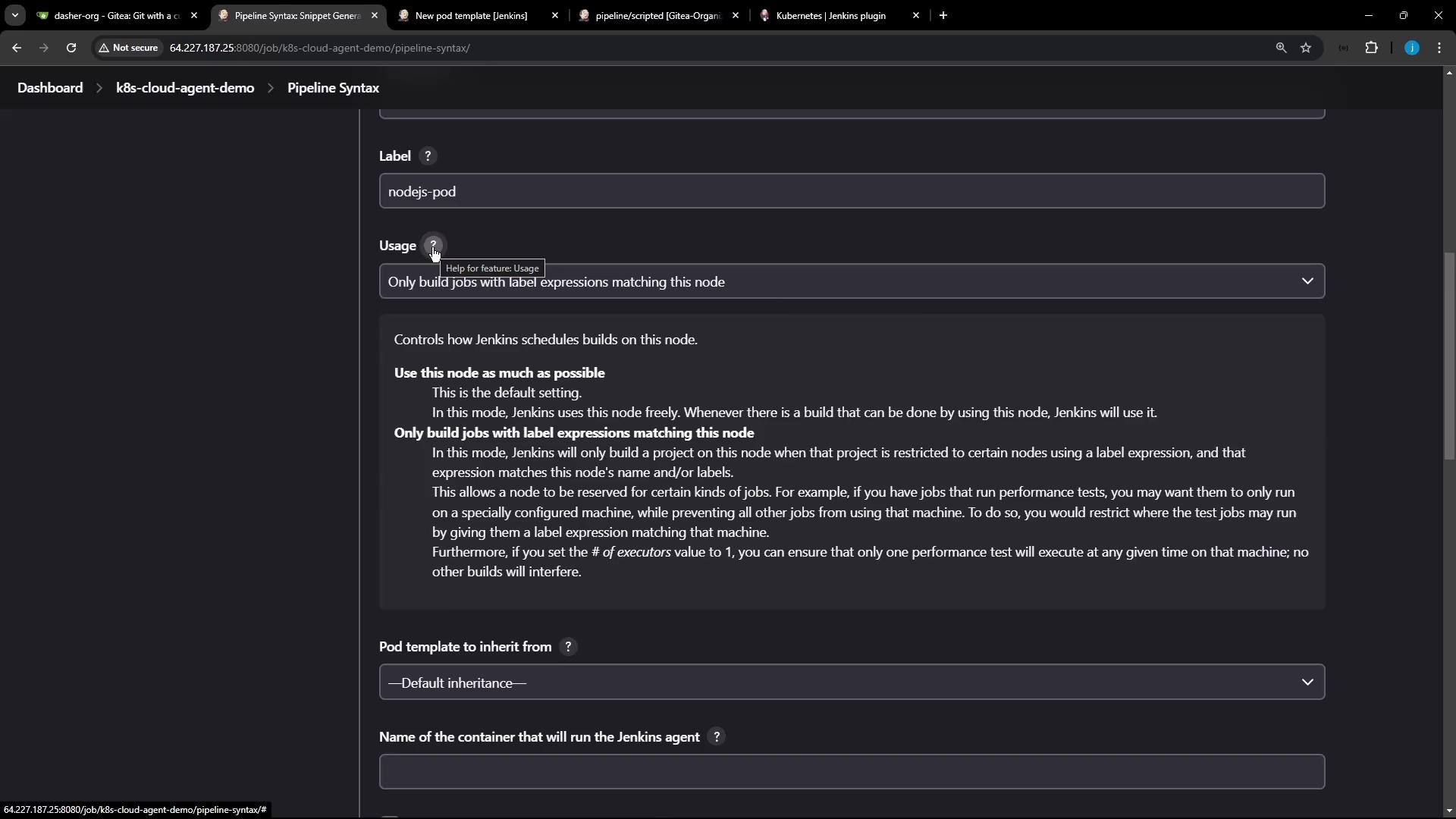
Define the container details:
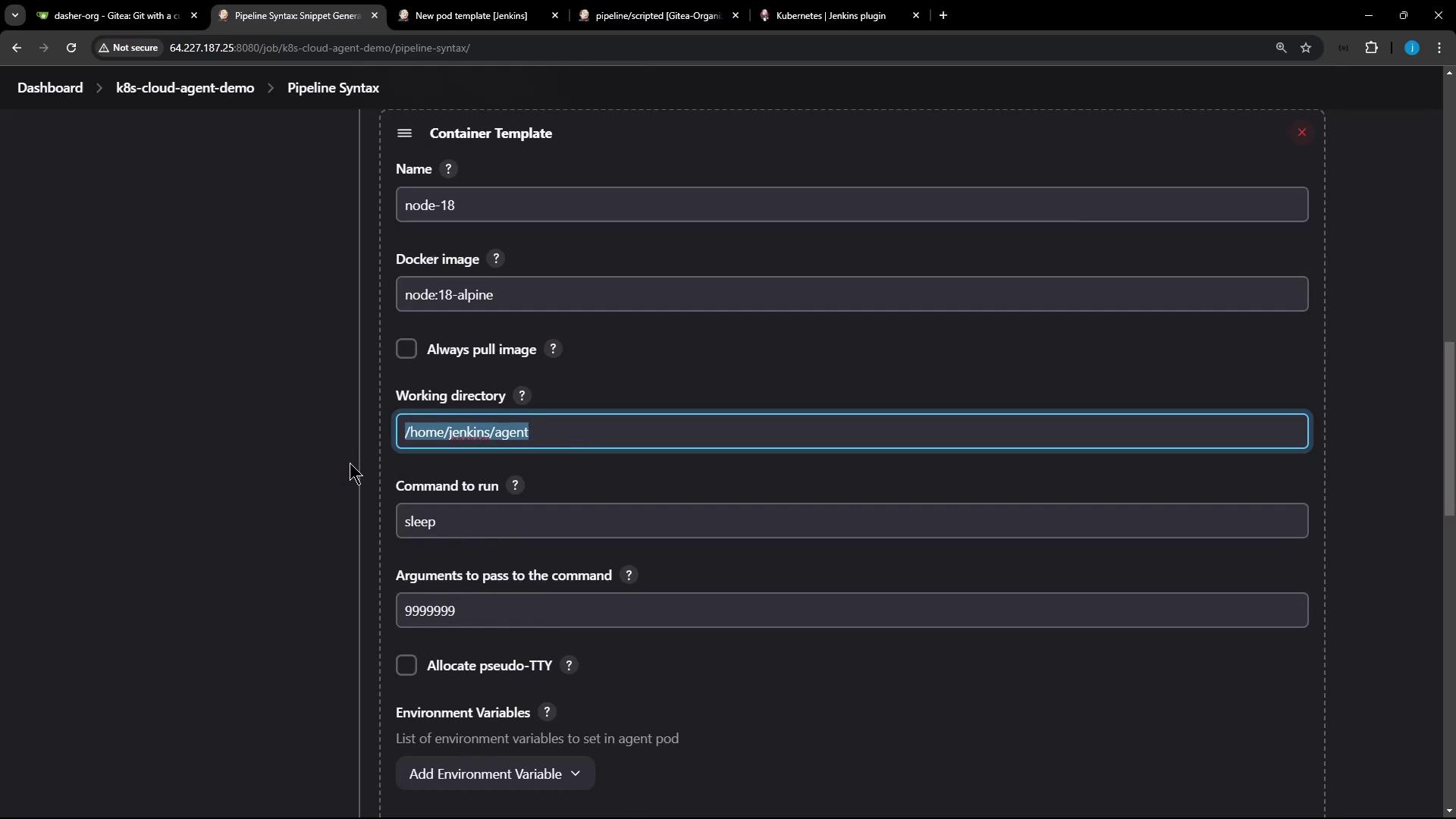
Clean up the generated snippet to only include fields you need:
podTemplate(
cloud: 'dasher-prod-k8s-us-east',
label: 'nodejs-pod',
containers: [
containerTemplate(
name: 'node-18',
image: 'node:18-alpine',
command: 'sleep',
args: '9999999',
privileged: true,
ttyEnabled: true
)
]
) {
// your scripted pipeline steps
}
Full Scripted Jenkinsfile Example
Below is a consolidated Scripted Pipeline that uses:
- A static node for checkout and dependency install
- A Kubernetes pod for isolated unit testing
- stash/unstash for sharing artifacts
#!/usr/bin/env groovy
podTemplate(
cloud: 'dasher-prod-k8s-us-east',
label: 'nodejs-pod',
containers: [
containerTemplate(
name: 'node-18',
image: 'node:18-alpine',
command: 'sleep',
args: '9999999',
privileged: true,
ttyEnabled: true
)
]
) {
// Static agent for checkout & install
node('ubuntu-docker-jdk17-node20') {
env.NODEJS_HOME = tool('nodejs-22-6-0')
env.PATH = "${env.NODEJS_HOME}/bin:${env.PATH}"
env.MONGO_URI = "mongodb+srv://supercluster.d83jj.mongodb.net/superData"
stage('Checkout') {
checkout scm
}
wrap([$class: 'TimestamperBuildWrapper']) {
stage('Installing Dependencies') {
cache(maxCacheSize: 550, caches: [
arbitraryFileCache(
cacheName: 'npm-dependency-cache',
cacheValidityDecidingFile: 'package-lock.json',
includes: '**/*',
path: 'node_modules'
)
]) {
sh 'node -v'
sh 'npm install --no-audit'
stash includes: 'node_modules/', name: 'solar-system-node-modules'
}
}
}
}
// Kubernetes Pod for unit testing
stage('Unit Testing') {
node('nodejs-pod') {
container('node-18') {
checkout scm
unstash 'solar-system-node-modules'
withCredentials([usernamePassword(
credentialsId: 'mongo-db-credentials',
usernameVariable: 'MONGO_USERNAME',
passwordVariable: 'MONGO_PASSWORD'
)]) {
sh 'node -v'
sh 'npm test'
}
}
}
}
}
$ git checkout -b pipeline/scripted
$ git commit -am "Use podTemplate for scripted pipeline"
$ git push origin pipeline/scripted
In Blue Ocean you’ll see the pipeline stages and Pod creation in action:
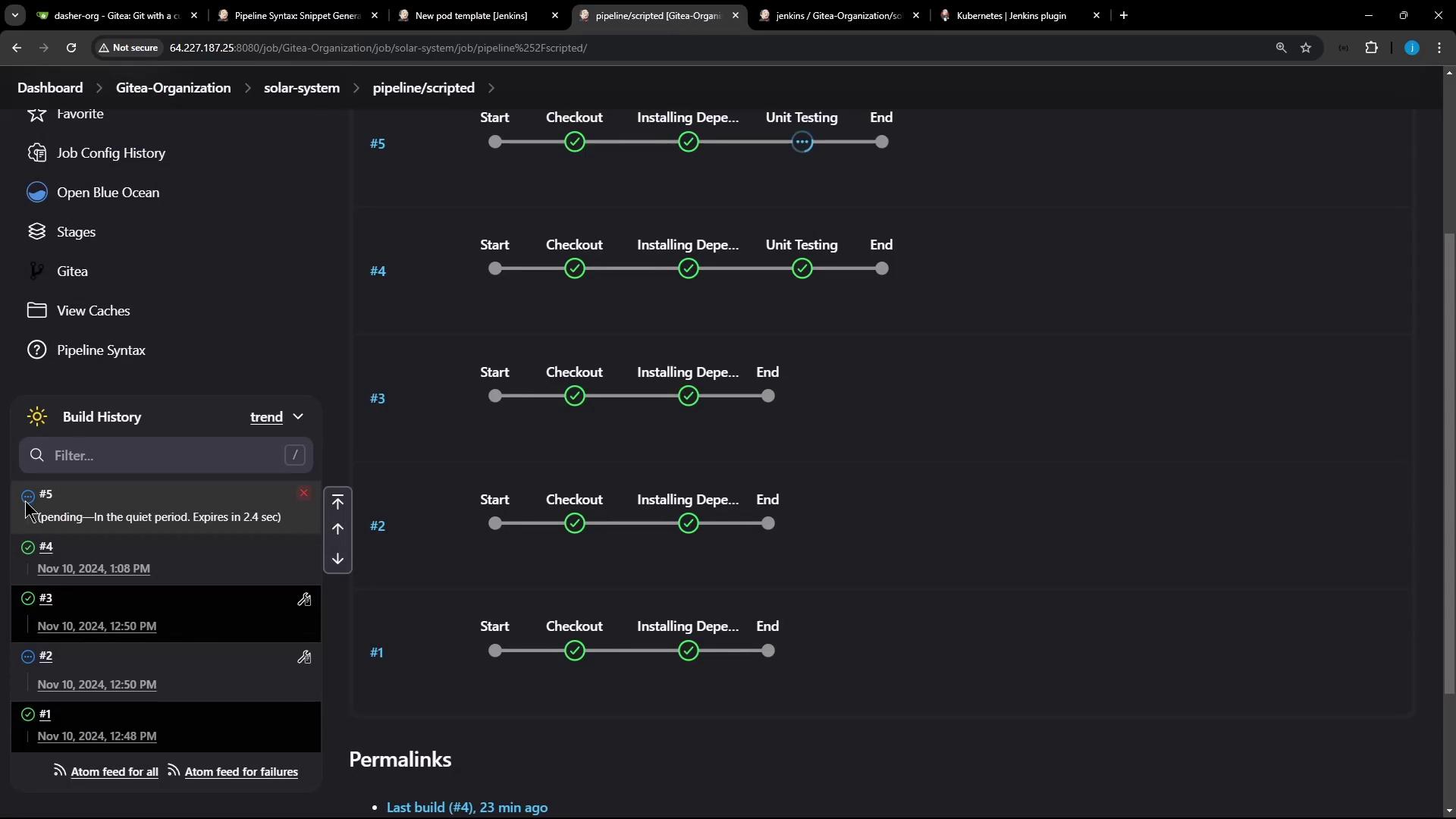
Under the hood, Jenkins spins up a Pod similar to:
apiVersion: "v1"
kind: "Pod"
metadata:
name: "nodejs-pod-XXXXX"
namespace: "jenkins"
labels:
jenkins/label: "nodejs-pod"
spec:
containers:
- name: "node-18"
image: "node:18-alpine"
command: ["sleep"]
args: ["9999999"]
tty: true
securityContext:
privileged: true
volumeMounts:
- mountPath: "/home/jenkins/agent"
name: "workspace-volume"
Once dependencies are unstashed, unit tests run inside the node-18 container:
+ node -v
v18.20.4
+ npm test
> Solar [email protected] test /home/jenkins/agent/workspace/solar-system
> mocha app-test.js --timeout 10000 --reporter mocha-junit-reporter --exit
✔ should retrieve the solar objects
√ will handle missing data correctly
2 tests complete (xxxxms)
Pipeline Stage Summary
| Stage | Agent | Tasks |
|---|---|---|
| Checkout | ubuntu-docker-jdk17-node20 | SCM checkout |
| Installing Dependencies | ubuntu-docker-jdk17-node20 | npm install, stash node_modules |
| Unit Testing | nodejs-pod (container node-18) | Unstash modules, run tests with credentials |
By combining a static agent for caching and Kubernetes pods for isolated execution, you achieve a scalable, flexible Scripted Pipeline. Use podTemplate, node, container, and stash/unstash to coordinate across stages.
Links and References
Watch Video
Watch video content
Practice Lab
Practice lab